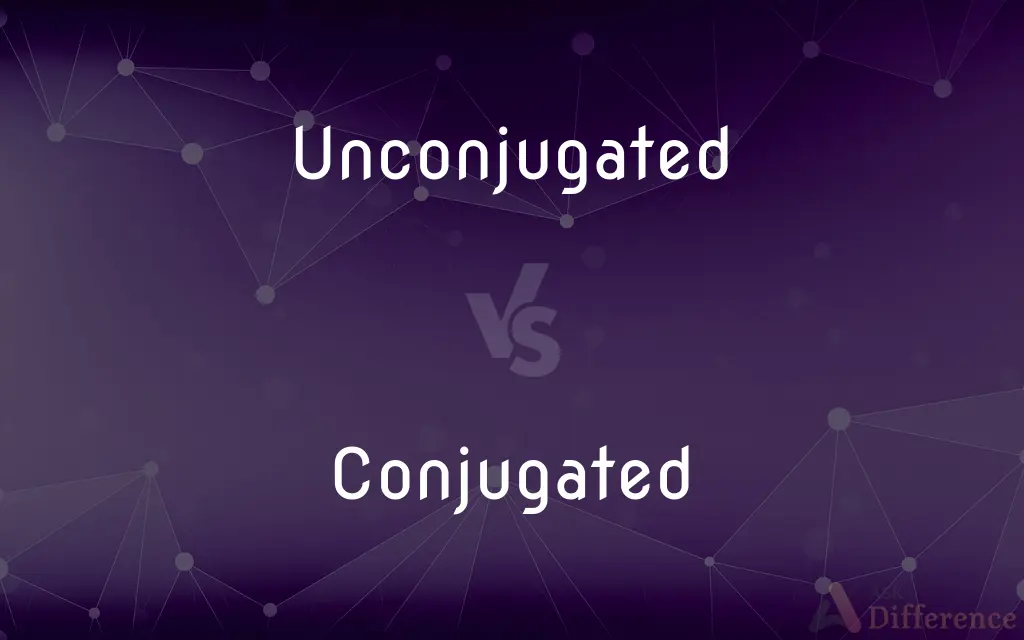Unconjugated vs. Conjugated — What's the Difference?
By Tayyaba Rehman & Fiza Rafique — Updated on April 1, 2024
Unconjugated bilirubin is not water-soluble and circulates in the blood bound to albumin, whereas conjugated bilirubin is water-soluble, being processed by the liver for excretion.

Difference Between Unconjugated and Conjugated
Table of Contents
ADVERTISEMENT
Key Differences
Unconjugated bilirubin originates when the heme from red blood cells breaks down, leading to a substance that is not water-soluble and travels to the liver attached to albumin. On the other hand, conjugated bilirubin is the product of the liver converting unconjugated bilirubin into a water-soluble form, allowing it to be excreted in bile.
The presence of high levels of unconjugated bilirubin in the blood can indicate issues with red blood cell breakdown, suggesting hemolysis or other disorders affecting red cells. Whereas high levels of conjugated bilirubin suggest problems with bile flow or liver function, indicating potential liver disease or bile duct obstruction.
Unconjugated bilirubin must undergo a transformation process in the liver, where it's conjugated with glucuronic acid to become more soluble in water. Conjugated bilirubin, therefore, represents a later stage in the bilirubin metabolism process, ready for elimination from the body.
Measurement of unconjugated versus conjugated bilirubin levels in the blood provides important diagnostic clues. Elevated unconjugated bilirubin points to pre-hepatic issues, while elevated conjugated bilirubin points to post-hepatic problems.
Treatment for high levels of unconjugated bilirubin often focuses on the underlying cause of increased red blood cell breakdown. In contrast, addressing high conjugated bilirubin levels may involve relieving bile duct obstructions or treating liver diseases directly.
ADVERTISEMENT
Comparison Chart
Solubility
Not water-soluble; circulates bound to albumin
Water-soluble
Origin
Result of heme breakdown from red blood cells
Produced by the liver from unconjugated bilirubin
Indicative of
Problems with red blood cell breakdown (pre-hepatic issues)
Liver or bile flow issues (post-hepatic problems)
Process required for excretion
Needs conversion to conjugated form in the liver
Ready for excretion in bile after liver processing
Diagnostic significance
Elevated levels suggest hemolysis or similar issues
Elevated levels suggest liver disease or bile duct obstruction
Compare with Definitions
Unconjugated
Indicates pre-hepatic issues when found in high concentrations in blood.
Elevated unconjugated bilirubin levels often lead to jaundice.
Conjugated
Bilirubin processed by the liver, making it soluble in water.
Conjugated bilirubin is excreted into the bile and eventually leaves the body.
Unconjugated
A form of bilirubin not yet processed by the liver for excretion.
High levels of unconjugated bilirubin may indicate hemolytic anemia.
Conjugated
Indicates liver function and bile excretion efficiency.
High conjugated bilirubin levels can signal liver disease or bile duct obstruction.
Unconjugated
Bilirubin that is insoluble in water, requiring liver enzymes for conversion.
Unconjugated bilirubin is carried to the liver bound to albumin.
Conjugated
Detected in blood tests to diagnose liver and bile duct diseases.
Doctors measure conjugated bilirubin to assess liver health.
Unconjugated
The initial form of bilirubin produced from the breakdown of red blood cells.
The liver converts unconjugated bilirubin into a conjugated form.
Conjugated
Treatment focuses on relieving bile duct obstructions or liver conditions.
Medications or surgery may be required to lower conjugated bilirubin levels.
Unconjugated
Managed by addressing the cause of increased red blood cell breakdown.
Treatment for high unconjugated bilirubin may include phototherapy.
Conjugated
The form of bilirubin directly involved in bile production.
Conjugated bilirubin gives bile its characteristic color.
Unconjugated
Not conjugated
Conjugated
Linked with another compound, or composed of two linked compounds
Conjugated estrogens.
Conjugated
Having two or more double bonds in alternation with single bonds.
Conjugated
Joined together in pairs.
Conjugated
Containing one or more pairs of double bonds and/or lone pairs, each pair being separated by a single bond.
Conjugated
Simple past tense and past participle of conjugate
Conjugated
Formed by the union of two compounds; as, a conjugated protein.
Conjugated
Joined together especially in a pair or pairs.
Conjugated
Containing two or more double bonds each separated from the other by a single bond; - of an organic compound or of the double bonds thus arranged.
Conjugated
Formed by the union of two compounds;
A conjugated protein
Conjugated
Joined together especially in a pair or pairs
Conjugated
Of an organic compound; containing two or more double bonds each separated from the other by a single bond
Common Curiosities
What does high conjugated bilirubin indicate?
It suggests liver disease, bile duct obstruction, or issues with bile excretion.
How are unconjugated and conjugated bilirubin measured?
Through blood tests that differentiate between the two forms, providing diagnostic information.
What is conjugated bilirubin?
Bilirubin that has been processed by the liver to become water-soluble, ready for excretion in bile.
What is unconjugated bilirubin?
It's bilirubin that hasn't been processed by the liver and is not water-soluble, indicating red blood cell breakdown.
What causes high unconjugated bilirubin?
High levels can be due to increased red blood cell breakdown or issues with liver bilirubin uptake.
How is high conjugated bilirubin treated?
Treatment may involve relieving bile duct obstructions or treating the liver condition directly.
Can both forms of bilirubin be elevated at the same time?
Yes, in certain diseases, both forms can be elevated, indicating complex liver or blood issues.
Why is conjugated bilirubin more directly related to liver function?
Its processing and excretion directly involve liver activity and health, reflecting liver function efficiency.
Is it normal to have both unconjugated and conjugated bilirubin in the blood?
Yes, both forms are normally present in low levels as part of the body's process of recycling red blood cells.
Can high levels of unconjugated bilirubin lead to jaundice?
Yes, as it accumulates in tissues, it can cause jaundice, a yellowing of the skin and eyes.
What treatments are available for high unconjugated bilirubin?
Treatment might include addressing the underlying cause of increased red blood cell breakdown, such as phototherapy.
How does the liver convert unconjugated to conjugated bilirubin?
The liver uses enzymes to attach glucuronic acid to unconjugated bilirubin, making it water-soluble.
What is the significance of measuring bilirubin levels?
It helps diagnose and monitor liver function, bile duct patency, and red blood cell lifespan.
Can liver disease affect both forms of bilirubin?
Yes, liver disease can impact the processing and excretion of both unconjugated and conjugated bilirubin.
Share Your Discovery

Previous Comparison
Rebound vs. Recoil
Next Comparison
Raita vs. RiataAuthor Spotlight
Written by
Tayyaba RehmanTayyaba Rehman is a distinguished writer, currently serving as a primary contributor to askdifference.com. As a researcher in semantics and etymology, Tayyaba's passion for the complexity of languages and their distinctions has found a perfect home on the platform. Tayyaba delves into the intricacies of language, distinguishing between commonly confused words and phrases, thereby providing clarity for readers worldwide.
Co-written by
Fiza RafiqueFiza Rafique is a skilled content writer at AskDifference.com, where she meticulously refines and enhances written pieces. Drawing from her vast editorial expertise, Fiza ensures clarity, accuracy, and precision in every article. Passionate about language, she continually seeks to elevate the quality of content for readers worldwide.















































